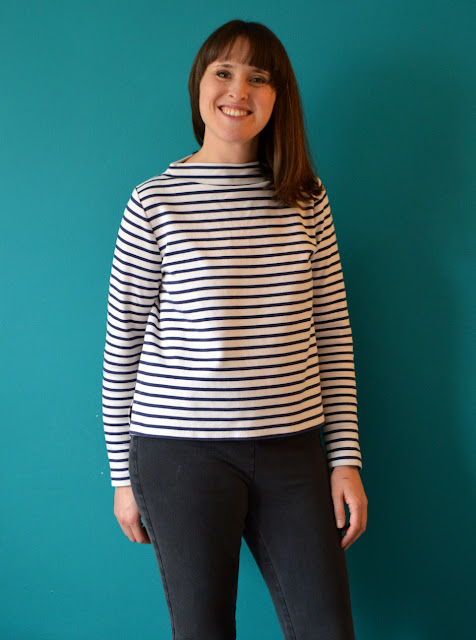There I go: progressing towards my aim to make every variation of a Breton-style top imaginable! I jest of course, but I really was feeling a hole where a long-sleeved striped top that's a bit more sophisticated than my fleece version should be.
Pattern:
I must admit, I wasn't an instant convert of either view of Sew House Seven's Toaster sweater pattern. However, a mixture of sensory adaptation brought on by near-continuous exposure to Toaster sweaters on Instagram, and my on-going lack of chilly-weather garments resulted in my giving it another look. I became intrigued, in particular, by the boxy silhouette and grown-on funnel neck of version 2, and when I realised my fabric stash already contained a strong candidate, a project was born.
Aside from using my overlocker to finish the raw edge of the neck facing, I atypically used my regular sewing machine for this knit project. I wanted the slower speed, and therefore control, to successfully match the stripes at the side and sleeve seams, plus I knew that creating the side slits would be easier if I didn't try and overlock some of the seam. I made the straight-up size M, and made no alterations aside from shortening the sleeves a bit. It was a fun and simple make, although granted I made it more difficult by the need for stripe matching.
Fabric:
It was during a self-imposed, fabric-buying ban that I came across this perfect Breton ponte at C&H (mini-chain of old-lady homeware and craft shops) at some point last year. It was such a lovely, thick, stable ponte that I almost had a little cry. My lovely mum saw that I was having some kind of internal crisis and very sweetly bought 2m for me. I'm not sure if technically that's cheating, but I have no regrets and I haven't seen it in there since. Annoyingly I didn't pay attention to the information on the tag so I have no idea of its fibre content.
If I recall correctly, my initial leanings for this fabric were towards some kind of casual dress. But the truth is, I so rarely wear dresses that aren't pinafores, that zero ideas for what to do with it bubbled up as it sat forlornly in my stash. So when the possibility of a Breton-friendly top pattern (the Toaster) appeared, it was a no-brainer for the Breton fabric to become a Breton top.
Another bonus of this gorgeous quality fabric is how wide it is: almost 2m wide in fact (I checked). I cut the Toaster pieces out carefully (which usually calls for 1.5m fabric), and I'm pretty sure I'll have enough for some kind of jacket/cardigan as well.
Thoughts:
As soon as I finished this top, it immediately went into regular rotation. The fabric washes beautifully, and even though this top has been both worn and washed multiple times, to me it still looks hot off the sewing machine. I'm very pleased that I remembered to add one of my 'Me-Made' woven labels from Dutch Label Shop (pictured above) to the back neck, but I talked myself down from adding any overt nautical touches like the small label at the hem made from woven anchor ribbon that I was considering.
The only criticism I have of this top is that I have found the neckline to be a touch too wide for comfortably wearing a cardigan over the top. I do anyway, but I prefer wearing it without. Bring on spring, in that case...















